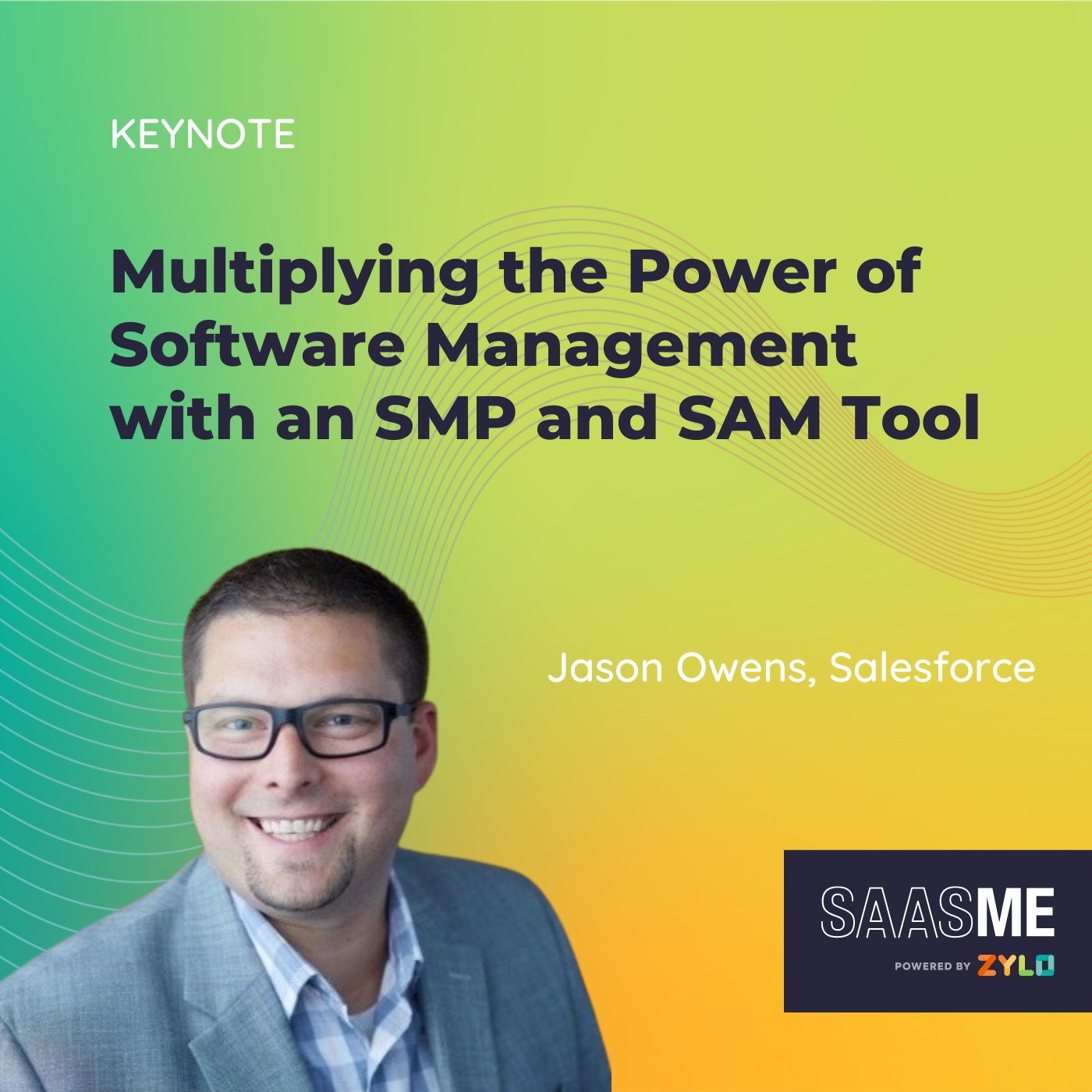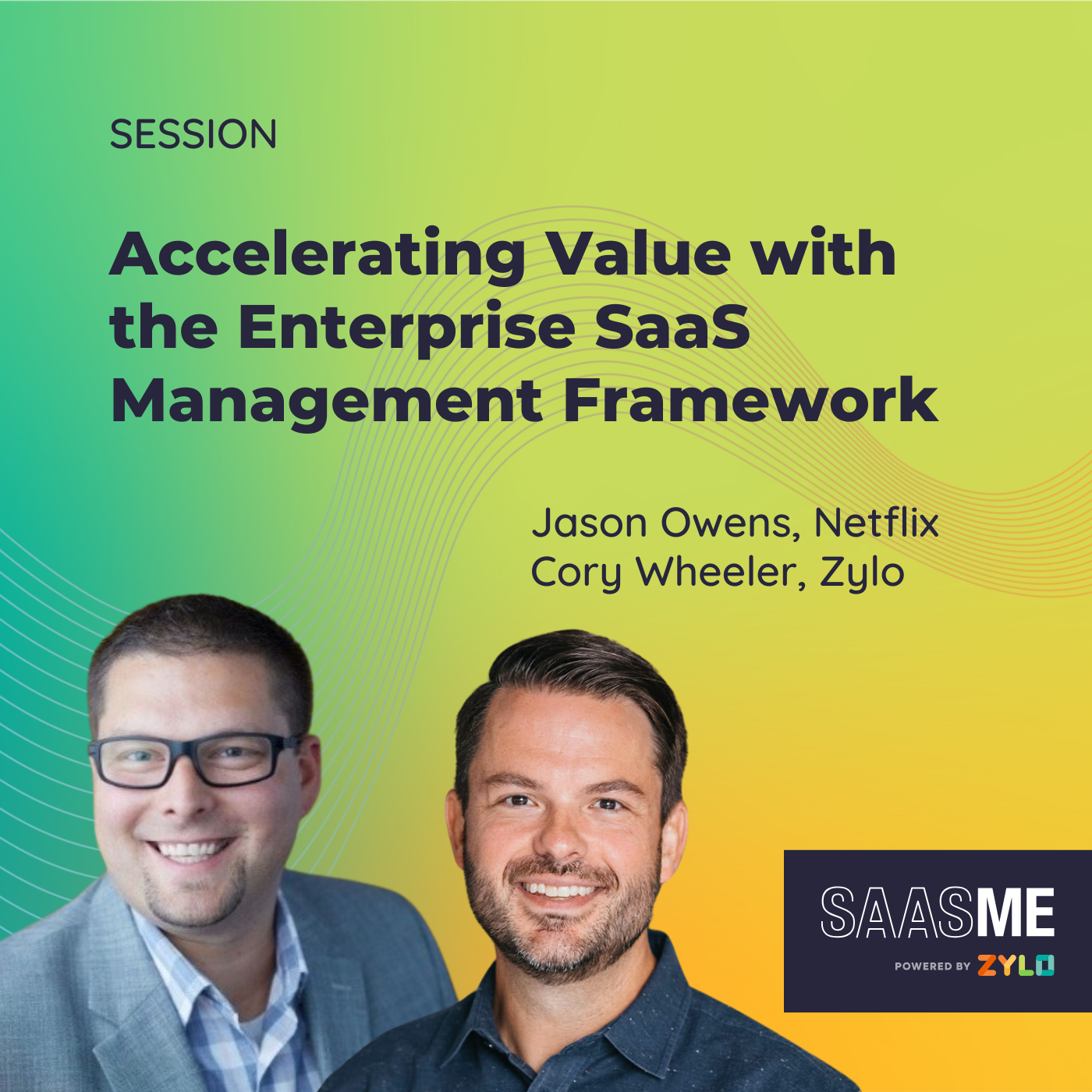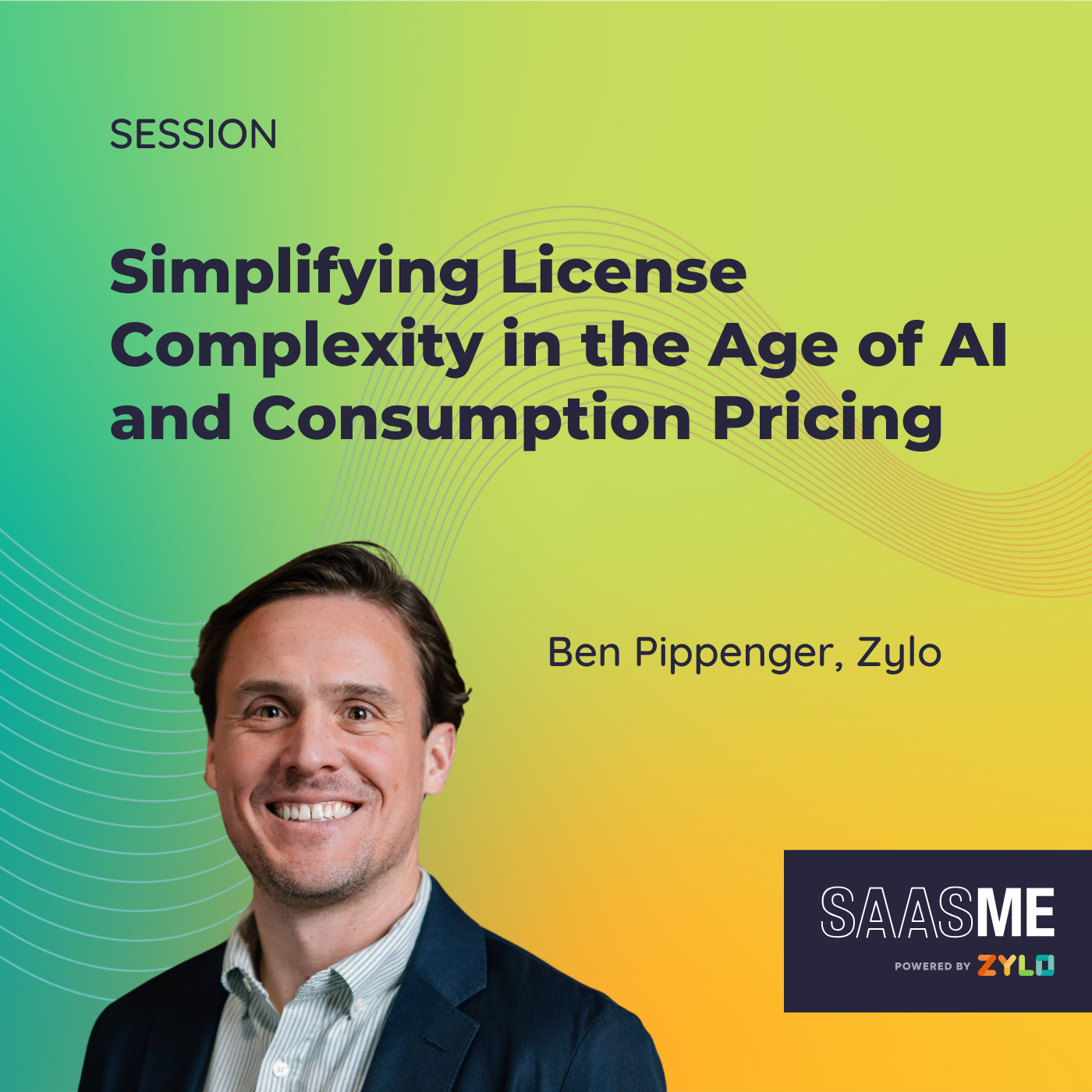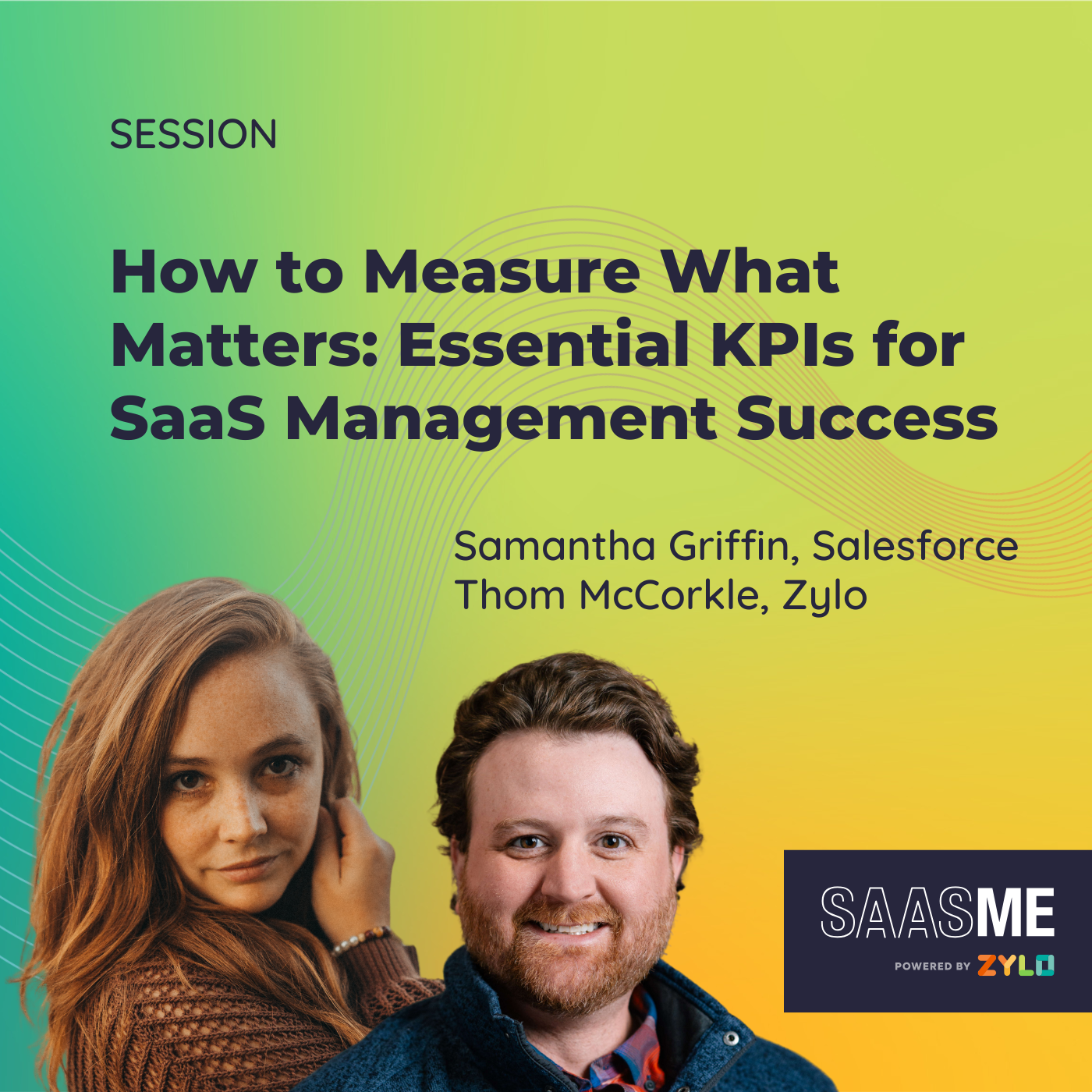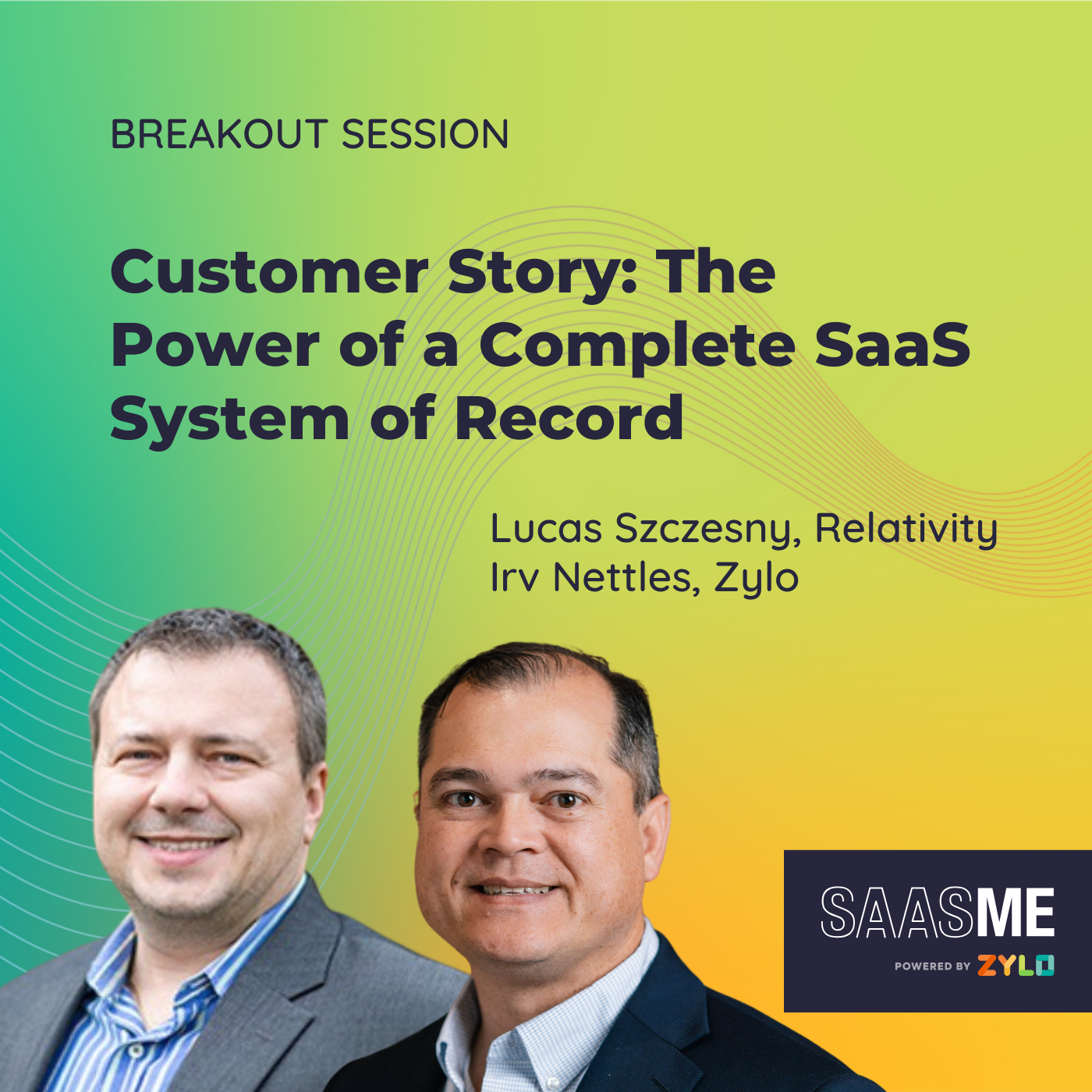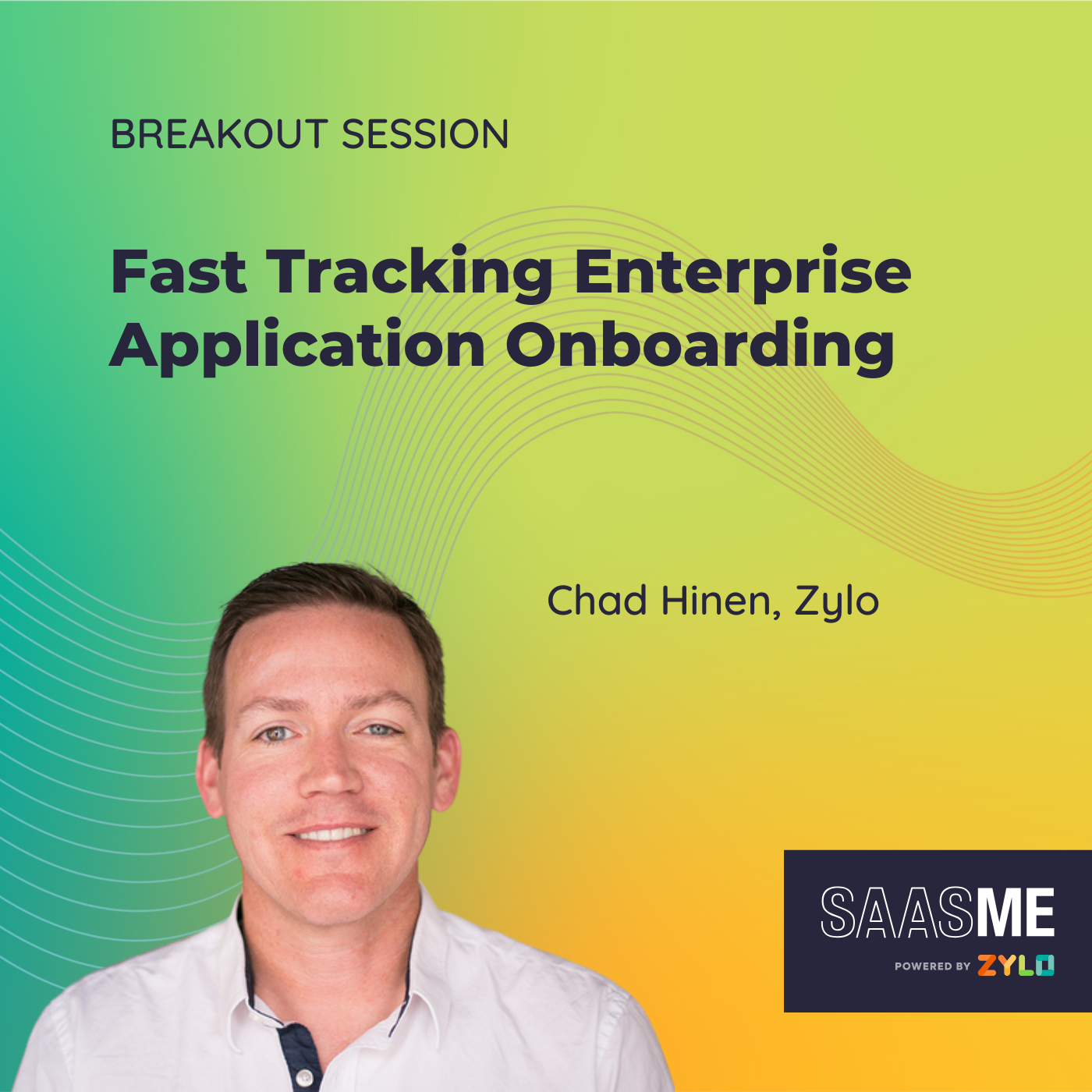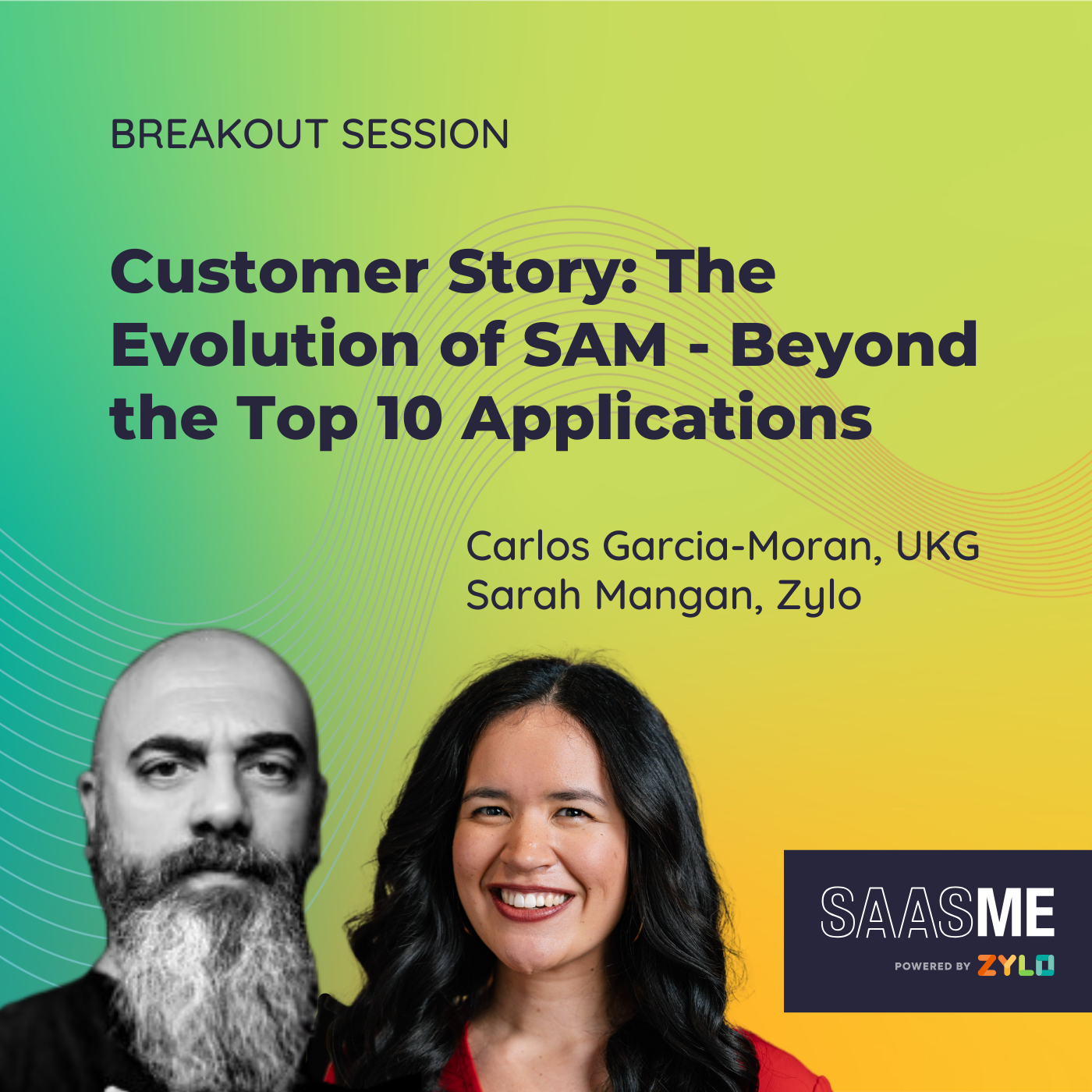Multiplying the Power of Software Management with an SMP and SAM Tool
- 0.5
- 1
- 1.25
- 1.5
- 1.75
- 2
Cory Wheeler: Hey everyone. Thanks so much, Meredith. Thanks for the introduction. Jason, thank you so much for joining us here today. As we start to get this kicked off, I'm really excited specifically to have Jason with us today. He is one of the foremost thought leaders in this SaaS management space and has a leading edge perspective on SaaS management and how it should be run. Don't laugh, don't be shy, Jason. That's exactly you. When you think about Salesforce today, Salesforce was the first cloud technology in the enterprise. And as such, they scaled before every other tech forward organization, or legacy or industry vertical. And they built their infrastructure operating model primarily around software as a service. So, they have experienced SaaS challenges that we've been talking about all morning at scale before any other company in any space or vertical. So, Jason on the stage today. Jason has 20 plus years in IT experience, eight at Salesforce, and is in the asset management business technology organization today. His career includes stops at the University of Phoenix, United Health Group, and Stratosphere Quality, and Automotive OEM. Now, at Salesforce, he runs the team that runs provisioning support and lifecycle asset management with a budget of over a$ 100 million in software assets. As Salesforce was one of the first companies tackling this SaaS challenge, he has experienced these challenges firsthand and we'll share his insight today. Now, from a personal perspective, he's an Indianapolis native as well, which naturally makes him an avid Motorsports fan and an IndyCar fan. He actually participates in his own IndyCar podcast and last year checked off a bucket list item when he went to the 24 hours of Le Mans. He's been a fantastic and strategic partner of ours here at Zylo. Welcome to the SaaSMe 24 stage, Jason Owens. How are you, Jason?
Jason Owens: I'm doing great, Cory. Thanks for that wonderful introduction. I hope I can live up to it. It was very kind. And I completely agree that the challenges of managing SaaS applications at the company that invented SaaS applications can be difficult on every day that ends in why.
Cory Wheeler: You're absolutely right there for those listening, pay close attention. Jason's conversation is strategic in nature, but also laced with execution, and the overall perspective of SaaS management within a scaling enterprise. So, we're going to start off our Q& A. We'll save a little bit of time at the end for anybody that's got questions in the chat. Jason, I'd love to start off. Before we get through that Salesforce journey of yours and walk through how that's evolved over time, we'd really love to understand the SAM persona. Part of our audience has SAM involved. Procurement has some of those activities that they execute as a part of a similar SAM strategy, but everyone is aligned around licensing inventory and renewal management. So, in your words, what is SAM accountable for today in the enterprise?
Jason Owens: So, that's a great question, Cory. And I think it gets to the fundamental the crux of who we are collectively as software asset managers and asset managers in general. Today, software asset managers are and should be responsible for either leading, spearheading, supporting, or evangelizing for the digital transformations of their companies. And what do I mean when I say that? It means that we have a collective responsibility. The 10,000 to 12, 000 software asset managers that exist in the world according to Forrester Research, is that we have this great nexus of where we sit between security, information, technology, finance, procurement, where we can advocate for business value unlike almost any other role that exists in either the enterprise or the SMB today. From a business value perspective, being able to go in and say, " Hey, we have these seven different products." If we rationalize these down to an n plus 1 strategy, we can pay 40% less, streamline our end user engagement, have an easier time for our service desk professionals to support the products in the enterprise, make it easier for people to know where to go to get what they need to do their job. And at the end of the day, drive value back into the enterprise through those cost savings that can be used to reinvest and deliver other transformational type activities for the company. And I don't think there's any other outside of sales who go out and get things done. There's not many other what we would traditionally call back office roles or cost center roles that are poised to deliver that kind of value to their enterprises. And I think a lot of C- suite executives these days are waking up to, hey, this isn't a traditional back office role. There's the ability to go deliver value out of these type of roles. And even just if you look at it from an individual career perspective, somebody that's starting their asset management journey today, there's a lot of parts of this work that we can say, hey, maybe this could be automated or we could leverage AI. But the asset managers that can both leverage automation and artificial intelligence to do their job better, all they will do is bring greater value to their enterprise. And that's the best thing you can do for your career is to bring value to your company.
Cory Wheeler: Yeah, I think you said that really, really well. Can you talk a little bit, maybe not specific to Salesforce, but just SAM in general, the role back in 2020 or even prior to that to now, how has that shifted? And has that become a closer alignment to the CIO and the CFO in general? What's that looked like over the last five to 10 years?
Jason Owens: That's a great question, Cory. Because I feel like four or five years ago, prior to that software asset management and asset managers in general were either seen as order takers or a cost of compliance. It was, " Hey, we're managing our assets. We're making sure that we don't have significant levels of either business cost or security risk. And hey, we're paying for this because we have to get our work done." Fast- forward four years, which by the way, I'm sure everybody else feels like the last four years have been 40 years. And then sometimes it also feels like it's been four days or four weeks. So, that's crazy. But four years ago, I was only managing software asset management at Salesforce. A couple of years ago I was asked to take over all of asset management. So, mobile, hardware, governance, compliance and software sitting in my purview. But I still believe that software has the greatest transformational capability out of anything in the asset management space today. Where we're at today and what we've seen is that software asset management is the way to unlock business value. Budgets are not going to continue to go up the way they were in the early days of the pandemic where it was, " Hey, pay for anything. We don't care. Whatever it takes to get people to do their jobs." That's not where we're at today. Anybody that follows the news knows that we've been through a significant journey over the last 18 months at Salesforce. And some of that has been wait, how do we take a step back, understand what we have, what capabilities we really need, and then rationalize that to what we should have in the future? Our chief transformation officer, SAM Chung, has a saying that I love, I can't take credit for it, but he says, " Pretty much all enterprise software out there sucks at some level. So, find the thing that does the most of what you need it to and cost the least." And so, driving to get rid of UI/ UX tools, pretty much everybody has a dozen or more. Well, why not get down to two and then drive efficiencies and business value back into your company? And the asset managers to find ways to do that are the ones that are going to excel and get ahead.
Cory Wheeler: Yeah, I couldn't agree with you more. Every conversation with you becomes inspirational to me. And it starts to align within the SAM space around... I'd love your thoughts on this. It seems like there are two different personas in SAM today. There are those traditional personas of software asset management leaders that are managing audits and on- prem deployments, and putting together effective license positions for renewals. And then there's the second, the newer group within software asset management that's tackling the SaaS space, and tackling it head on, and viewing software not differently between on- prem and SaaS, just viewing it as software with a different delivery model that needs to be solved for. Do you see that in the SAM market today?
Jason Owens: Not only do I see that, but I feel like I live that on a daily basis. Really, there isn't a dichotomy when it comes to looking at compliance- focused, traditional on- prem license management and ELP delivery. And then there's, hey, there's the SaaS stuff. We don't really need ELPs because we can see our current license position in the portal at the drop of a hat. My belief is that it's not an either/ or. It's a yes/ and. You have to be able to deliver both of those, particularly today where there are companies. Especially if you're at the enterprise level, you still have a ton of legacy, or heritage, or whatever we want to call the traditional software model that grew out of a physical CD key that you had to catalog and keep in a drawer somewhere. To today where your ELP is literally just logging in and seeing what your portal says. And so, it's not either/ or. You have to be able to do both effectively in order to manage your software portfolio. And it's finding that healthy tension and where in your specific company and your enterprise, the low- hanging fruit and the largest value drivers are for your company that will bring value to you, and your career, and your company that they can either reinvest or return to stakeholders.
Cory Wheeler: Yeah, that's well put. I think you hit on a topic there that I want to draw on a little bit. You talked about effective license positions, and really being able to log in for SaaS tooling, and see the information in real time. What do you view as the primary differences between legacy heritage on- prem software strategies and SaaS software management as you are now operationalizing both of those internally at Salesforce?
Jason Owens: So, that's a great question. From the heritage focus, my perspective is that that's a compliance and risk management activity. It's important. It has to be done. There is compliance risk of either an external audit or vendor audit that comes from defined license levels and deployment where the vendor doesn't have visibility 100% of the time to what you have deployed. Whereas when it comes to a SaaS platform, both you and the vendor know at all times what you have deployed and what licenses you have access to. So, at that point, the focus for asset managers should not be on, " Oh, I'm maintaining compliance with my contract." It is where are my opportunities to understand my usage and utilization models, so that if I have people that are using a high price software on a quarterly or biannual basis, that we're not letting those people occupy a seat for 12 months out of the year. That we're either finding something else for them to use or we're creating mechanisms internally either through automation or through license management practices and license assignment practices, where we only give them the license where they need it. And we keep always being mindful of what our contractual obligations are to the vendor. But at the same time, it doesn't do either myself or the vendor any good to have somebody occupying a seat that's not receiving business value from the money that we're paying for that seat. And I think that's the fundamental crux of the discussion, is that we're paying for something. And if we're not receiving value for it, we shouldn't be paying for it. And we've had some difficult conversations with vendors over the last 18 months where we've said, " Hey, we know you see all these people that are logged in and have licenses assigned." And when we look at the usage and utilization data, they're not really getting the value out of X or Y percent of those seats. And we need to have some tough conversations about that. Because it's also not great for the software vendor long- term in the marketplace if they just have people occupying seats at Shelfware. And I think that's a discussion that I don't think has reached a significant portion of the SaaS market yet. That it's all about let's focus on viral, let's get as many people in seats as we can. Let's grow it organically. But if people are just occupying a seat just to charge for a license, that's not a healthy relationship either the consumer or the vendor that is selling the seat.
Cory Wheeler: Yeah. Well put. I think there's sometimes a little bit of perception in the market perception within the enterprise. We heard from Gartner earlier today, which where I think we're seeing some of that perception shift. But some of that is, " Hey, well, we've already got asset management in place, so we should just be able to pick up SaaS and it should be easier. So, let's just wrap this into our program and keep moving forward," without really looking at the specialization that SaaS requires. So, you at Salesforce have implemented a dedicated SaaS strategy, certainly with Zylo partnering up to drive that going forward, why do you see a need for a SaaS centric solution? And before you knew that you needed a SaaS management platform, what did you try? Did you try legacy solutions? How did you try a solution for that before leaning in with Zylo to centralize all of that for you?
Jason Owens: That's a great question, Cory. And you've been around, you've been here when we've gone through an RFP for what our asset management platforms would look like. This is one of those yes/ and questions. You need to have both because you have two fundamentally different types of software in enterprise and you need to be able to manage them both well. I think there's a question here about where are you on your journey as an asset management organization? Do you work in a highly regulated industry that you need to have that legacy heritage on- prem nailed down so that you can minimize and show business risk when it comes to external auditors? Or are you at a company that's rapidly growing that is shifting its business model that is SaaS forward? There's not a one size fits all answer here. It's either/ or is really situationally dependent. I think the fastest way to business value is with a SaaS management platform. If you have an early stages or a nascent... If you're looking at the maturity model and you're at a zero one or even an early stage two, in a maturity model perspective, it probably makes sense to invest in a SaaS management platform first because you're going to be able to show value realization to your executives on a much quicker timescale. And then you can use that to say, " Hey, this is why we also need to capture and manage on the other side." It's not an either/ or question. They're very complimentary platforms. You need to have both, particularly at the enterprise level. And that comes from somebody that works in a space where... Heck, Salesforce invented SaaS software. There is not a day that goes by that my job is not challenged by the fact that I'm in an industry that was invented by the company for which I work. And I remember my early days as a software asset manager, I would go to industry events and I would say, " Hey, what are your challenges?" And people would say, " Hey, where do you work?" I'm like, " At Salesforce." They're like, " We can't talk to you because we're Salesforce customers." And so, it is interesting. But at the end of the day, the answer is you need to have both. And how you fit that into your specific situation is highly dependent on where you need to deliver business value and then on what timeframe.
Cory Wheeler: Yeah, so I think that what it sounds like you're articulating is this is a better together story with a traditional SAM solution and a SaaS management solution Zylo at Salesforce. Can you articulate at Salesforce what that looks like for you?
Jason Owens: Yeah, so here we have both. I'm not going to say names. Obviously we have Zylo because I'm here today. But we do have a traditional on- prem software discovery and software asset management platform in- house because we're at... I don't know what the accurate figure is. We've reported the street, but we're at 70,000 plus employees. 1. 1 to 1. 2 devices per end user. The whole fleet of enterprise software solutions, end user productivity tools, everything exists within our environment. And what I mean everything, I mean everything. Up until 18 months ago, we at Salesforce said, " Hey, we're the world's largest startup. Whatever software you need to do your job, go out and buy it." And I can't even begin to articulate how difficult that is as an asset manager to work in that environment. We've come a long way over the last 18 months where we have a application rationalization strategy, we have a roadmap, we have a software governance council. We've started to really drive towards an n plus 1 strategy across all of our fleet of software. Complicated by M& A of course. Always is. But really it's like you said, it's a better together story. You can't do it only with either. And it's incumbent on us and our responsibility as asset managers to be able to show the business value to our leadership teams that, " Hey, you should and need to have both of these in order to deliver a performant asset management organization for your enterprise."
Cory Wheeler: Yeah. Well put. I think when we've talked to SAM leaders historically, they'll always talk about the need for great data. To be able to not only what the expenses are around the organization, but how those tools are being leveraged, and then centrally tracking all the metadata around that. So, as you think about the actions that you take for on- prem versus cloud, how are the actions that you take within Zylo different than what you would take or anyone would take out of a legacy SAM tool? And is that all centered around the data?
Jason Owens: It's 100% centered around the data. And I don't want anybody to think that we have this 100% figured out at Salesforce. We are on our maturity journey. We're not at a five. We're not at a four. We're somewhere probably around a low three. But what we do know is that we're on a journey and we want to figure that out. And so, when we look at what actions and activities we want to leverage the platform for, we tend to, and this isn't 100% all the time, but we tend to leverage our internal software discovery tools in a more reactionary manner, where we say, " Hey, we have either an audit." Or security has come to us and said, " Hey, what does this look like?" That it is a push- pull request basis when it comes to what we're leveraging that for. Or we use it directly for a renewal prep at the six, five, four month markers out from a renewal. When it comes to the SaaS management platform, it's a much more proactively focused tool, in that we're saying on a monthly basis, what does our usage look like? Is our user base up or down? How are we looking for the percentage of users that have actually logged into the platform this month? So, again, we come back to the yes/ and better together story. But from a SaaS management platform perspective, it really is focused more on the proactive activities. And I think as asset managers, we all know intrinsically that if we're working in the proactive space versus the reactive space, we are setting ourselves up for future success. And I like to tell my team this, it's like, what are you doing today to make your job easier tomorrow? And a SaaS management platform, unlike pretty much any other platform that exists out there is really a critical tool in the tool belt to make your job easier tomorrow. So, tomorrow you looks back and says, " Man, I'm really glad I did that yesterday." Not, " I wish I had done that yesterday."
Cory Wheeler: Yeah. You BT SAM at Salesforce, your organization, you're a little bit of a unicorn because you directly... I mentioned it in your intro, you're accountable for over a$ 100 million in total spend. Many of the applications that are centrally governed at Salesforce are centrally governed by your team. So, as you think about the apps that are under ownership by BT internally and IT, how do you measure them? What is good? As you look at the utilization of these applications and you look at the sprawl of applications, you've got an accountability for those core solutions that drive business at Salesforce. How do you evaluate those? When you look at spend, and when you look at utilization and usage of those tools?
Jason Owens: This is one of those things where there's not a discreet easy answer. It's really difficult and it sometimes comes down to per platform metrics. And again, this is one of those things that we're still in the... We have the growing pains in this space. And it's like there's not a one size fits all solution across heritage on- prem apps, SaaS apps. It really comes down to the discrete licensing model for each platform. You have some things like if you look at incentive compensation planning where everybody that's in the user pool has to have access to that. And the usage and utilization may not be as important because if a salesperson needs to see what their incentive compensation looks like, they need to have access no matter what. Whereas if you're looking at a platform that's like digital or collaborative whiteboarding, maybe there's a differentiated persona where there's some folks that update compliance documents on a quarterly basis. And there's some folks that use it for Igniter design sessions on a daily or weekly basis with customers. And it's understanding really getting down to the nitty- gritty of what are the personas? And what are the stakeholder use cases that drive value for your individuals that you want to understand so that then you can manage the licensing pool in an effective way for all of those individuals? And if you can't suss out that differentiated value stream between the different user bases of a tool, because there are. We tend to think as asset managers, it's like, I'm going to look at a chat tool, either Slack, or Teams, or Google Chat. It's just being used for people to talk to each other. But actually, some people are talking to customers. Some people are using it for workflows. And it's what do the differentiated personas look like? What are the value streams for those stakeholders? And then understanding when and where to pull back licensing based on the individual value stream. Making those art and science calls is where you can drive value back into your business.
Cory Wheeler: Makes a ton of sense. Picking up on an earlier comment that you made, Salesforce has been historically very in acquisitive. I've even heard some rumblings in the news recently as well. But you're a big part of that. You could speak to this a little bit. But you're a big part of acquired entities at Salesforce. How do you drive your SaaS strategy for onboarding companies or acquiring companies year over year?
Jason Owens: That's a great question. And not that I have any visibility into what's coming on the M& A roadmap. I find out when it hits the news. That's when I find out when we're acquiring somebody. So, when it comes to M&A, it's both a pain point and an opportunity. One, it's an opportunity to understand are some of these software titles potentially better than what we have? And I think that's one thing that we don't ever talk about really well when it comes to M&A and acquired companies, is that sometimes there may be a software tool that's in your acquired company that's better than what you have. And you should be open to having those conversations. It doesn't mean that you allow for 24, 36 months of multiple or dueling tools or titles in a category. But it means you should ask the whys and be curious at the start. And then I'd be lying if I said it was easy. Acquired company integration is probably one of the most difficult things that companies will do, particularly when it comes to the software stack. And I look at where we've come. Five, six years ago, Salesforce was like, " Hey, we're going to acquire these companies and they can run whatever they want. They can do whatever they want." And so, we had to deal, and manage, and handle all of those things as we move forward. But today it's very much how do we gracefully move an acquired entity into our standard procedures, process, platforms, and tools in a way that's respectful to the journey that they're on. And I think that the key part there is respectful. Because we've all seen in our careers that it's like sometimes there's an acquisition, it's like thou shalt conform. And there's no kindness or empathy that's granted to the difficulty that somebody who's at an acquired company is going through a transition in their career where they don't know, " Hey, am I going to have a job tomorrow? What is my job going to look like? Am I going to work for somebody new?" There's so much going on there that we can help as asset managers in the transition, bring folks over to a new organization and say, " Hey, maybe the tools that you will use to do your job may change over the coming months. But we're here to support you and make sure that the tools that you do get will help you get your job done. And we're committing to make that happen."
Cory Wheeler: Yeah, that's very well put as well. We've got some great questions in the chat. So, I'm going to round out our question and answer session. With a quick look at your specific Salesforce journey. You mentioned it earlier, 2023 to 2024, SAM feels like it's very much in the spotlight. And probably everyone listening today, cost optimization is a focus. It began a couple of years ago in the innovation space where growth shift moved to efficiency and profitability. And that has rippled through every vertical in every industry. So, probably everyone on the line today is saying in some way, shape, or form, " I'm accountable and I'm closer to the strategy of our business than I've ever been before." Can you talk about that shift in Salesforce and what opportunity that is bringing to you and your team, your career in the industry overall? What does this shift look like as it relates directly to SAM in the enterprise?
Jason Owens: So, first off, Cory, that may be the best question you've asked all day, particularly for the audience that we have here on the line as career asset managers. Salesforce, we love to talk about the fourth industrial revolution. Hey, it's the fourth industrial revolution. We're actually really there right now with the rise of not just machine learning, but with ChatGPT, the AI models that we're seeing today. There has been no greater opportunity as an asset manager to drive business value into your enterprise than there exists today. When I started in asset management at Salesforce, I came from desktop support. I actually was in an asset management role, came to Salesforce and desktop support because it was the employer of choice here in Indianapolis and thought, this is a step back in my career. But we all know careers zigzag. Sometimes to get better opportunity, you move laterally. And when I joined the SAM team, there were three of us. And all we were managing was a couple on prem apps and the Microsoft EA. And today we are accountable for all of the business technology software spend. We run and manage the monthly software governance council, which is responsible for making sure that our forward- looking strategy when it comes to applications that we're bringing into the enterprise or renewing is aligned with our business focus. And really when I look at the landscape, even though we've had all of this energy and all this opportunity over the last five to seven to eight years, there's still more opportunity today than there ever has been. And I'm telling you, if you as an asset manager are not using AI tools to ask questions about what are the products in this category? And what are they compare and contrast? Things that we used to have to do manually that would take days, or hours or, days and you can get a quick answer and then validate. There are so many opportunities to differentiate yourself as an asset management professional today that didn't exist. And I know I'm rambling because I get excited about this because there's so much opportunity in our space today. And I know that this doesn't apply really to Zylo or SaaS management tooling in general, but there's a lot of salespeople out there in the SaaS space that don't want you as an asset manager to leverage those tools because they have a boat payment on the line. And you know what? Your fiduciary duty, your value that you bring as a thought leader in your space to your enterprise can be leveraged upwards multiple times over by leveraging those tools. And there literally has never been an opportunity to be more transformational for your enterprise than there is today when it comes to being a SaaS and asset management professional.
Cory Wheeler: Fully agree with that. Very well stated. I think I'm going to get you excited about the next question. We have a wonderful question from the chat. We've talked a lot about backend value optimization, cost reduction, efficiency metrics. But in SAM, you play a big role in defining value and ROI on the front end of the process as well. So, the question was, you mentioned getting value from tools. How do you measure tool ROI on the front end and on an ongoing basis at Salesforce?
Jason Owens: So, that's a great question. What we do is we measure two primary metrics. We measure cost savings against budget. So, we create a budget towards the end of every fiscal year for the following year. And as we go into the year, we track discreetly against from a renewal perspective and from an application rationalization perspective, did we save money against what we thought we were going to spend this year? And I think this is more critical for the executive conversations for your asset management program, is that we track what is our cost, not savings, but what is our cost avoidance that because we have this program, we were able to not spend X dollars on a true up? Every license we reclaim, every time we decline a net new software onboarding because we're in front of every single net new software onboarding at Salesforce. Every time we perform either one of those actions, it goes into our Tableau dashboard that we present on a monthly basis to our executives. And we say our value is not the cost savings versus budget. It's also this giant opportunity cost that we have avoided as an enterprise because we have rigor in our day- to- day practices and management. And getting to those two numbers. Even if you can start to show on a monthly basis, " Hey, we worked with procurement. We're IT, but we worked with procurement and security to say,'No, don't onboard this new tool.'" Or put a T& E card policy in place so that people can't expense software on their T& E cards. And then capture what that value is. Capturing those cost avoidance metrics and cost savings metrics will define the value that your program brings. And candidly, the cost of our program is like one seventh to one eighth of the value that we bring to Salesforce by being here. And other than sales, and this is one of the things that I think is great about asset management, other than sales, who else can go out and say that I have an ADEX return on the money that my program has been entrusted with? There's not a lot that can say that. Sales, totally. Everybody else is like, " Yeah, we get people to do their jobs." We have hard metrics that say, look, we return to ADEX our cost this year to the business in terms of the value that we either saved or avoided. And that's the brass tax level of, " Hey, here's our value. We need some investment to go get more." Or, " You should allow us to bring in one or two more SaaS professionals to deliver more of this value." That is the foot in the door of opening the conversation of how do we do more?
Cory Wheeler: Yeah. Last question for you. We've got a couple questions in the chat asking scoping around your program, which I think are really good questions for everybody to hear. When you went live with Zylo, you got visibility centralized into every application across your business. Two- part question here, how do you define what applications are viable for you to own in BT, manage in BT, provision, deprovision, and thereby leverage detail directly in Zylo to drive an optimization structure for? How do you scope those out? And the second question is how do you define SaaS tools in the broader context around SaaS management? So, do you look at pure play user- based apps and you're managing those across wide deployments? Do you look at platform apps that maybe might have managed services attached to them, like your payroll services platforms and things like that? What's that structure that you use to define and scope the specifics of your SAM program?
Jason Owens: I'll answer the second part first. The quick and easy answer is it's a journey. As I stated earlier, we started with on- prem productivity tools, and we've grown. Today, we're only managing IT applications. So, 18% to 22% of the enterprise. My goal is that three to four years from now, we're a board chartered software asset management organization that manages from a FinOps platform infrastructure as a service perspective, all of the digital software assets that exist within Salesforce. Huge goal, right?
Cory Wheeler: Right. Dream big.
Jason Owens: Dream big. We're going to go and execute and we're going to get there. So, short answer is we're not where we need to be. You never are. We're going to get there. But the way we get there is by looking at the first part of the question, and it's saying, we got to go execute. And in today's days of tight budgets, that makes not a lot of sense. But in today's tight budgets, we're not going to get extra headcount to go do this stuff. So, what we have to do is we have to look at MSP partnerships. We have to look at automation, RPA, AI, wherever we can find a way so that my asset managers are not stamping widgets, but they're using the art and science components of their work to deliver business value. And that anywhere we have that widget stamping, we automate it and then we continue to make our asset managers more valuable to the enterprise. And candidly, it's a better job experience if you're not on an assembly line, stamping a widget every day. And so, we have to continue to find those opportunities to drive additional value. Mindful we're close to time, but there is, and I just want everybody to hear that's on this call. We are in the early stages of a software asset management revolution, where software asset management will be seen in three to five years, what developers were seen as 15 or 20 years ago. It is such a fundamentally exciting job, and role, and career opportunity that... I don't know. I get excited about it. And I want people that are in college here. You don't have to go program. You don't have to go into sales. There's this really cool thing that is at the intersection of data. It's at the intersection of AI. You get to work with business leaders. And most important of all, you get to have an outsized impact on your business and write your own ticket in your career. It's pretty darn cool.
Cory Wheeler: It is pretty darn cool. Jason, the size and scale of what you've implemented, being on the leading edge of how software management is evolving, taking on more challenges as they come, really being an example of the SAM team that has the most responsibility that I've seen cross industries in my experience, it's inspiring not only to hear that, but also to hear the passion in your voice around operationalizing software management for the large enterprise. We are incredibly lucky to have you as a partner here at Zylo. And I thank you today for joining us on the SaaSMe 24 stage. Really appreciate you jumping in today, Jason.
Jason Owens: Thanks, Cory. And I'd be remiss if I didn't call... I'm not here doing this by myself. I will be 100% remiss if I didn't call out Piyush Kattri, who owns our SAM program. Pratik Sharma, Martin Brophy. We're so fortunate. Their whole teams. We have 20 software asset management professionals here at Salesforce. They're the ones that do the work on a daily basis. They get excited, they deliver the art and science. And without them, I wouldn't be here talking to you. So, it's a huge thanks to them and the entire team. And thanks for the opportunity to share the good word about what software asset management and a SaaS management platform can do in an enterprise.
Cory Wheeler: Absolutely. Kudos to the whole Salesforce team. Thank you so much for joining us, Jason.
Jason Owens: Thanks, Cory.
Cory Wheeler: Bye.
DESCRIPTION
Double your insights and control with a combined SaaS Management Platform and Software Asset Management strategy. SAM tools excel at on-premises management, but SMPs uncover the invisible: longtail SaaS apps, shadow IT, and hidden risks. Join this session and discover the magic when you use both an SMP and SAM tool in tandem. Explore the unique strengths of each approach and learn how to combine them for unparalleled visibility, cost optimization, and streamlined management.
Speaker: Jason Owens, Senior Director, Global ITAM at Salesforce

